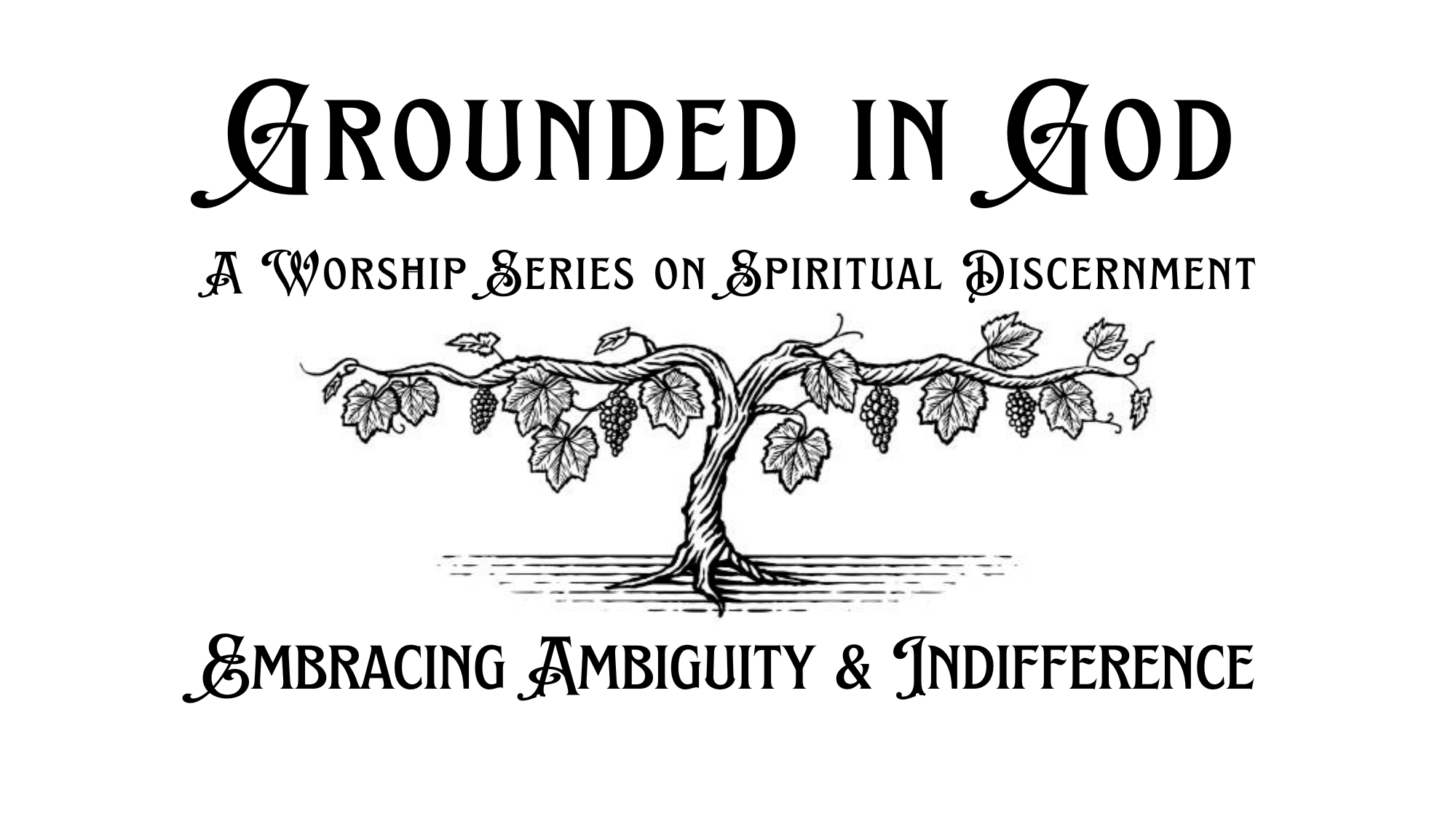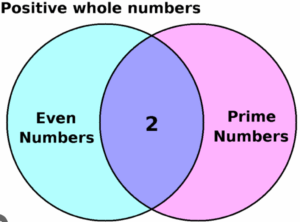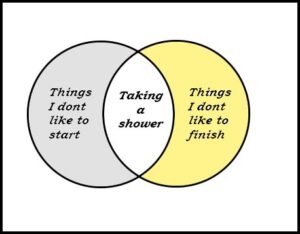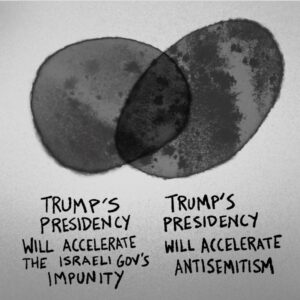
Embracing Ambiguity and Indifference
Texts: John 15:1-9; 1 Corinthians 2:7, 10-16
Jesus said just “abide in me” and Paul said God’s wisdom is a mystery.
It sounds like a riddle when it’s put like that. The riddle how to discern the Spirit and will of God? On the one hand Jesus makes it sound so clear: just abide in me and you’ll understand God’s intention and desire. And on the other hand, what?
In John especially, Jesus’ language about our connection to the divine is kind of like this. I used to know a Spiritual Director who loved John and she would talk about this passage in particular using lots of arm motions: in and through and up and down and all together. And I would roll my eyes a little (in my mind – never in front of her) because again, what? How? Give me something useful.
But the truth is, Spiritual discernment is a bit [waves arms around]. Understanding the mind of Christ is a mystery. But Paul was confident that we could actually access the mind of Christ through the power of the Spirit within and among us. That’s where spiritual discernment comes in.
Discernment means to sift through or or distinguish or sort out. When we engage in spiritual discernment, whether individually or in community, we’re distinguishing the voice of God from all the other competing voices and sense the leading of the Spirit.
Ruth Haley Barton, in her book Pursuing God’s Will Together is even more pointed. She says, “Spiritual discernment is the ability to distinguish or discriminate between good (that which is of God and draws us closer to God) and evil (that which is not of God and draws us away from God).”
Spiritual discernment is really as much – or more – about the process as it is about the outcome. It is prayerful and it is informed and it is intentional. By prayerful I mean that discernment itself is a form of prayer because it’s always harkening back to the mind of Christ. It abides in the vine. Abide is kind of an old fashioned word.
In fact when I looked it up, neither of the meanings that popped up in google were the right ones – (to accept or act in accordance with a rule or decision; to tolerate) – I had to click the ‘show more’ arrow to get to ‘continue without fading or being lost’ and finally (archaic) ‘to dwell/live.’ And that’s what we’re talking about. Our discernment lives in constant connection to Christ.
This is what Grounded in God says:
Spiritual discernment differs from other kinds of discernment because it is grounded in a conviction that the Holy Spirit is an active presence and, when in a group, the leading party in the proceedings. Christ is present at the center of each person and alive in the group – speaking, forming, and touching – waiting to be heard and recognized. Those assembled want to let go of barriers, both individually and collectively. They want the Spirit to guide them in shaping an issue so that it reflects what is important to God.
In other words, the starting point for spiritual discernment is acknowledgment that the Spirit is indeed at work and that I am – and together we are – listening for and seeking to follow the Spirit’s call.
After that central acknowledgment, being a part of a spiritual discernment process means a couple things. And they all in one way or another have something to do with release and embrace.
First, while good information and sound analysis are really important to the work of discernment, we’re spiritual discernment invites us to release the idea that what we’re doing is rational problem solving. This kind of process is does not have a formula, cannot be check-boxed to success. It may not be linear. It may not follow a timetable.
I’ll be honest, that can be super frustrating! I love a list. And checking boxes is very satisfying! While it’s possible for lightning to strike and for a person or group to align quickly around an idea or direction that’s clear, more often, it takes time and it’s a little meandering. But also, sometimes in the practice of spiritual discernment it can seem like nothing is happening, like there hasn’t been any movement and suddenly a resolution opens in a surprising and immediate and unexpected way.
Second, we are called on to release certainty and clarity, embracing ambiguity and uncertainty. Understand that more than one thing can be true – even when they conflict with each other. An image that I have found really helpful in releasing this for myself is the idea of Vent Diagrams.
I’m sure we are all familiar with a venn diagram. You can picture it: two circles that overlap to indicate where they have an idea or fact or characteristic in common. A couple of examples from a quick google:
Straightforward math:
Humorous:
But a VENT diagram is an idea developed by two women – educator E.M./Elana Eisen-Markowitz and artist Rachel Schragis – who say they are “two queer white jews on turtle island.” They define their program this way:
We define a “vent diagram” as a diagram of the overlap of two statements that appear to be true and appear to be contradictory. We purposefully don’t label the overlapping middle.
Making vent diagrams as a practice helps us recognize and reckon with contradictions and keep imagining and acting from the intersections and overlaps. Venting is an emotional release, an outlet for our anger, frustration, despair — and as a vent enables stale, suffocating air to flow out, it allows new fresh air to cycle in and through.
A come examples arising out of the politics of the last few years:
Elana and Rachel and practitioners of Vent Diagrams see the open space between two contradictions or the ambiguity in the uncertain middle as opportunity to both release the emotions – fear, anger, grief – and to find creativity.
As a Christian who believes in the power of the Spirit, I see that space as the place where the Spirit can move and work. Acknowledging, articulating and even leaning into the true contradictions and the uncertainty and the questions makes way for that movement.
Another – and final for now – point of release is to let go of preconceived ideas and expectations and outcomes in favor of indifference. Yes! Be indifferent. It doesn’t sound great, does it. I sounds like I’m making a decision not to care any more. But this was also a big turning point of my personal understanding of Spiritual Discernment and process. Because actually it probably means more spiritual investment and ‘work’ than arguing a position.
To be indifferent in this context is to release my own agenda in favor of listening for the sense of the spirit within the gathered community. This isn’t to say I can’t have a strong opinion, or even a preferred outcome. But clinging to that over listening for the Spirit’s movement within myself and within a community doesn’t align with a discerning process and honestly will probably only end up in frustration and maybe even hurt.
Ruth Haley Barton is where I encountered the idea of Holy indifference. She says we should be praying to be indifferent. She says:
Another kind of prayer that is associated specifically with discernment is the prayer for indifference. In this prayer we ask God to work in our hearts to make us indifferent to anything but the will of God.
This kind of indifference and willingness was Mary’s response when the angel came to her and told her that she would give birth to the Messiah. “ Here I am, the servant of the lord; let it be with me according to your word” (lk 1:38). It was Jesus’ prayer after he had struggled In The Garden of Gethsemane: “ not my will but yours be done” (lk 22:42)…
We often pray for wisdom while we are already attached to some outcome we think is best! Indifference is an important prerequisite to the prayer for wisdom precisely because the wisdom of God is foolishness to the world. when we have become indifferent to our need to be seen as wise in the eyes of others, then we are ready to receive wisdom from God
I have observed that when groups release personal expectations of an outcome – kind of like that open space in the middle of the vent diagram – new possibilities arise.
My example of this – which I feel like I can use because I wasn’t directly involved – is the small group from SMC who worked with the Faith Land Initiative from the Church Council of Greater Seattle in discerning how/to whom/where to offer the former MVS house.
As you might expect, members of SMC had pretty strong ideas about who they thought should receive that property – from land trusts to non-profit developers and the like. During their work with the consultants from the Faith Land Initiative, the team learned about the Trans Women of Color Solidarity Network (TWOCSN) and their search for a house that could offer respite and organizing space. The house – in a historically queer and also historically red-lined neighborhood – met many of their needs and the saving and fundraising that they had been doing for a down payment could now be used for repairs to a house that really needed some love.
When this possibility was reported to the rest of the congregation, while it wasn’t an instantaneous decision, it did feel like a Spirit filled breakthrough after a long discernment.
Maybe it should go without saying, but I will finish with this. All of these points of release and embrace are grounded in God – are grafted to the vine of Jesus Christ. As human beings it’s basically impossible to release any of it – our own agendas, out desired outcome, our need for certainty and clarity – without turning back to God for help.
Haley Barton talks about entering into discernment in prayer – including the prayer for indifference I talked about before – and that all of this is grounded in prayer.
There are all kind of ways of praying – many of them you are already familiar with; many of them you probably already practice. I get to be very wordy in prayer a lot of the time; I write prayers, I’m asked to pray spontaneously. I find that very meaningful. But leaving aside a fountain of words and instead embracing a select few, and redirecting our attention instead to the breath – the life and Spirit within us – can also be a very powerful and centering way to meet God.
All that to say, we are going to practice making room for the Spirit through our breath today.
Breath prayer is a form of centering prayer, a prayer during which you let the breath form the rhythm of the prayer. If you are anything like me, your mind might wander as you attempt to be contemplative or prayerful. Breathing a prayer to God is a simple way of using your body to engage your mind on the ‘mind of Christ’ to use Paul’s terminology.
Often this is by using a word or phrase from scripture, and repeating it on the inhale and exhale: Like this:
[inhale] “the Lord is my Shepherd.”
[exhale] “I shall not want.”
But developing breath prayers that meet the moment or choosing words or phrases that are personal to yourself is also a way to practice this. For example, Cole Arthur Riley, author of This Here Flesh and Black Liturgies regularly shares brief meditations or quotes followed by breath prayers for grounding in resistance. At the beginning of Lent, she posted the following prayer:
[inhale] “This is too much to hold.”
[exhale] “So we hold it together.”
We are going to be co-conspirators this morning. That is we will conspire – literally breathe together – and as we conspire we will be invited deeper into the Spirit. Today I invite you to use the words from our centering scripture:
[inhale] You are the living vine
[exhale] We live and grow in you
I know that this isn’t going to be for everyone, but I hope you’ll give three minutes to giving it a try. I’ll ring a bell to begin and end our time of silence together.
Find a comfortable seated position. You may want to close your eyes. Or at least unfocus your gaze. Begin to be conscious of your breath entering your body. Follow the course of the breath through into your nose or mouth and down into your lungs, feeling it fill up your body and then again as you release it follow it back.
Begin to add your prayer. And any time your mind wanders or gets distracted, return to the breath and to the prayer. You are the living vine. We live and grow in you.
—




